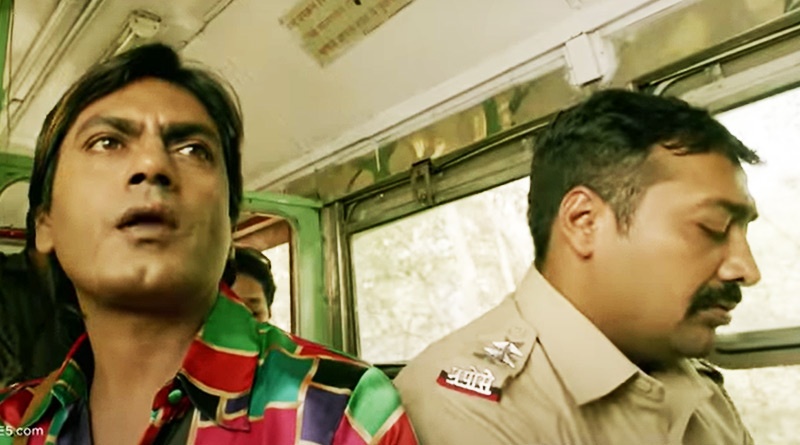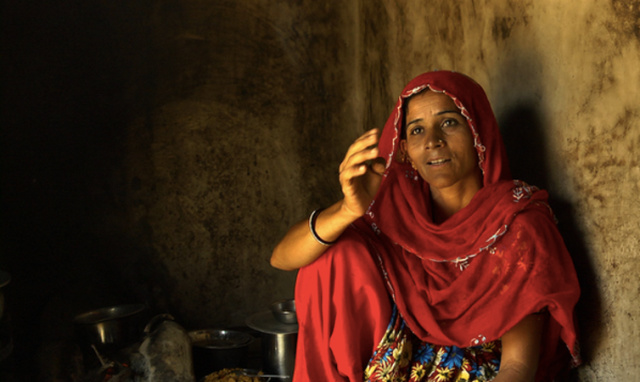
By Anjali Monteiro, Tata Institute of Social Sciences and Jayasankar K. P., Tata Institute of Social Sciences
A Delicate Weave (Jhini Bini Chadariya), a documentary film set in Kachchh, Gujarat in Western India, traces four different musical journeys, all converging in the ways they affirm religious diversity, syncretism (blending of religions and cultures) and love of the other in a country where religious politics too often divide communities.
Drawing on the poetic and musical traditions of poet-mystics Saint Kabir of Benaras (circa 1500) and Shah Abdul Latif Bhitai of Sindh (1689–1752), as well as the folk traditions of the region, these remarkable musicians and singers bear testimony to how these oral traditions of compassion are being passed down from one generation to the next.

KP Jayasankar
It can take several forms. In Bhujodi, a village close to the city of Bhuj, in Gujarat, a group of young men meets every night to sing devotional songs. They are all weavers and feel a special bond with Kabir, who was also a weaver. They are mentored by Naranbhai Siju, a carpet weaver by profession and a remarkable self-taught community archivist, who spends his spare time recording and annotating this body of devotional music.
The women from Lakhpat, an ancient port close to the border between India and Pakistan, quietly subvert gender roles through their folk music performances. They are the first group of women in Kachchh to perform in public – and this has changed their lives.
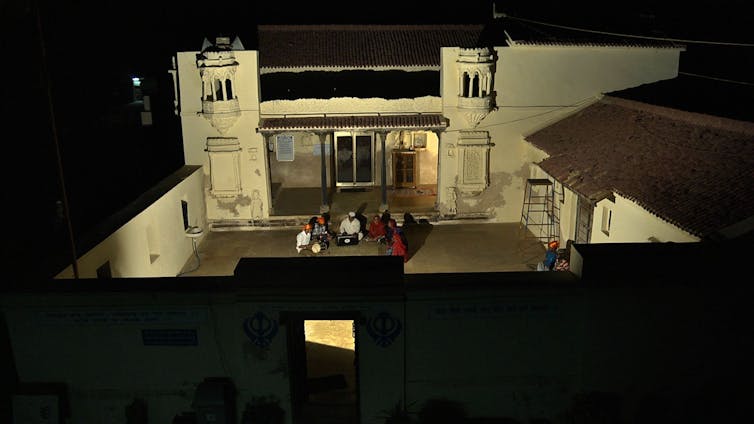
KP Jayasankar
Noor Mohammad Sodha is a master flautist from Bhuj who has been playing the jodiya pawa or double flute for more than 25 years, performing in India and also overseas. He has recently begun teaching three young people his skills, in the hope that this tradition will live on.
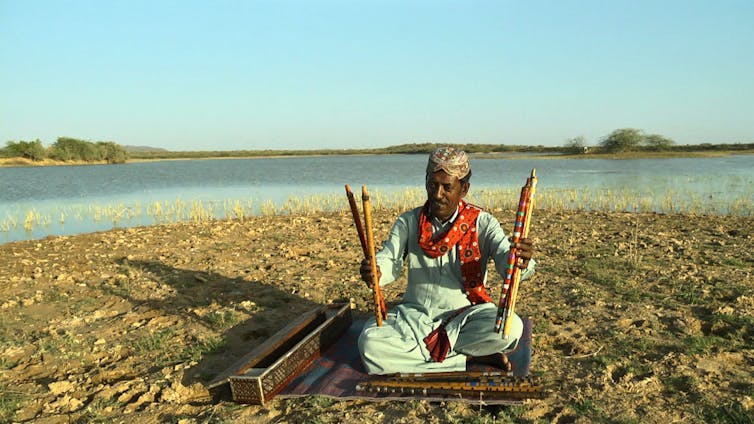
KP Jayasankar
Jiant Khan, 60, lives in the Banni grasslands of the area. On two nights every week, he meets people who travel from far-flung villages to sing the verses of the Sufi poet Shah Bhitai in the musical Waee form, a style from the northwest of India and beyond, performed with string instruments. Five years ago, there were only three people left in India who sang this rare and ethereal form – now the number has gone up to eight.
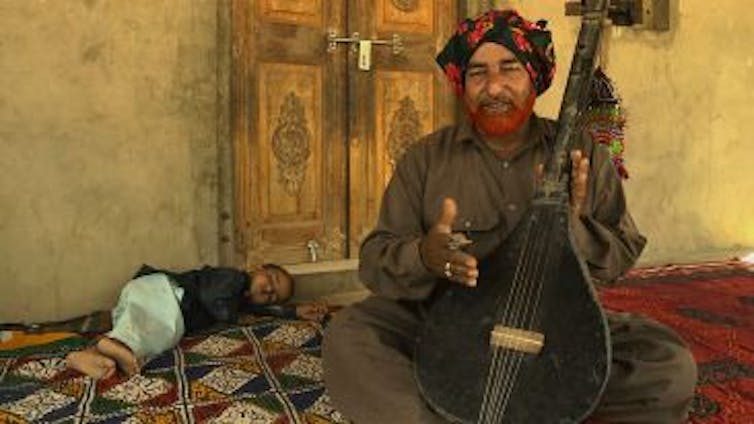
KP Jayasankar
All these passionate musicians keep alive this delicate weave, committed to the project of what Naranbhai calls “breaking down the walls” – walls that have been built up through the politics of hate and intolerance that marks current times.
Pastoralists living in harmony
Since 2008, our team from the School of Media and Cultural Studies at the Tata Institute of Social Sciences in Mumbai have been creating video documentaries of the music of pastoral communities, in the region of Kachchh in Gujarat. This has resulted in the making of our three films – Do Din Ka Mela (A Two-Day Fair), So Heddan So Hoddan (Like Here Like There) and A Delicate Weave.
Gujarat witnessed ethnic violence directed against the Muslim minorities of the state in 2002, in which more than 2000 people are estimated to have been killed. Kachchh, though a part of Gujarat, remained unaffected by this outbreak of violence. We were inspired to explore the socio-cultural fabric that makes Kachchh an island of peace in a sea of intolerance and embarked on a process of documenting the Sufi traditions of music, storytelling and poetry that is an integral part of the lives of the pastoralists that live there.
This region has a long tradition of nomadic pastoralism, with many different communities that moved from Kachchh, across the salt desert known as the Great Rann of Kachchh, to Sindh, now in Pakistan, with their flocks of cattle and camels in search of pastures, in a process of rotational migration.
This movement over millenia resulted in strong kinship and trade ties between Hindu and Muslim pastoral or Maldhari communities in Kachchh with their counterparts in Sindh and Tharparkar across the Rann of Kachchh.
In earlier times, their religious identities were somewhat inconsequential and fuzzy. Many of these groups were nomadic people, with their own beliefs and practices, and there were also strong fraternal relationships between different communities, across religious persuasion, supported by stories about these ties from mythology and folklore.
Harder borders
The 1947 Partition of India transformed the lives of these communities forever, accentuating distinct and mutually exclusive religious identities – the new border became a faultline for divides that had never existed. The pastoralists were now hemmed into recently imagined nations, which continued to re-enact the tensions brought into play by Partition, their movements restricted forever.
After 1947, the border was somewhat porous until the India-Pakistan conflict of 1965, after which crossing over became increasingly difficult and the Rann became a militarised zone.
The emergence of hard borders, that are fenced and fortified, is not the only threat to the semi-nomadic pastoralism of the Maldharis. The past few decades have witnessed a slow and steady destruction of these ways of life, through the state’s environmental policies, the promotion of industrialisation, the proliferation of ecologically insensitive tourism and the bureaucracy’s condescending and cavalier attitude to these communities.
Fragility of life
Sindh and Kachchh share a common heritage, based on Sufism and other syncretic practices, as well as a shared repertoire of poetry, folklore, embroidery, architectural practices and visual culture.
The Bhakti poetry of Kabir, the 15th century mystic weaver-poet, is sung and recited across communities and religions. Shah Abdul Latif Bhitai the Sindhi Sufi poet wrote the Shah jo Risalo in late 17th century, a remarkable collection of poems that continue to be sung by communities throughout Kachchh and Sindh.
Many of these poems draw on legendary love stories, which speak of the fragility and finitude of life, the inevitability of grief and an ultimate surrender to and union with the infinite.
Our documentation work at the School of Media and Cultural Studies, Tata Institute of Social Sciences, has often been in collaboration with the organisation Kutch Mahila Vikas Sanghatan (KMVS) which spreads the belief that culture, music, language and lived traditions form an important component of empowerment initiatives since 1988.
One of these initiatives has brought together musicians of various communities, initially through community radio. The musicians now have their own association that helps in organising programmes, mentoring younger musicians and keeping these musical traditions alive and robust.
Over the years, but particularly after the earthquake of 2001, which killed more than 12,000 people, there have been many changes in the social fabric of Kachchh.
The earthquake brought in external intervention in a big way, in terms of reconstruction and rehabilitation, both by the state and non-governmental organisations. Today, Kachchh has also become a tourist destination, with the state-sponsored Rann Utsav (Desert Festival) that takes place between November and February and brings in thousands of tourists, with obvious effects on the fragile ecologies of the Rann and the grasslands.

KP Jayasankar
The effects of these changes are complex. While on the one hand, tourism and external markets have provided a boost to local arts, crafts and artisans, on the other, the ways in which they change relationships within communities can pose problems for community living. Exacerbating these changes is the shift towards parties on the political right in Gujarat, including Kachchh, which threatens the traditionally fraternal and symbiotic relationships between diverse communities.
This is the backdrop against which A Delicate Weave explores efforts to teach and learn these endangered musical traditions and sustain the utopian energies that characterise Sufi and other syncretic ways of being. These traditions affirm notions of diversity and peaceful co-existence within this precarious yet resilient social fabric.![]()
Anjali Monteiro, Professor at the School of Media and Cultural Studies,, Tata Institute of Social Sciences and Jayasankar K. P., Dean, Professor School of Media Studies, Tata Institute of Social Sciences
This article is republished from The Conversation under a Creative Commons license. Read the original article.




